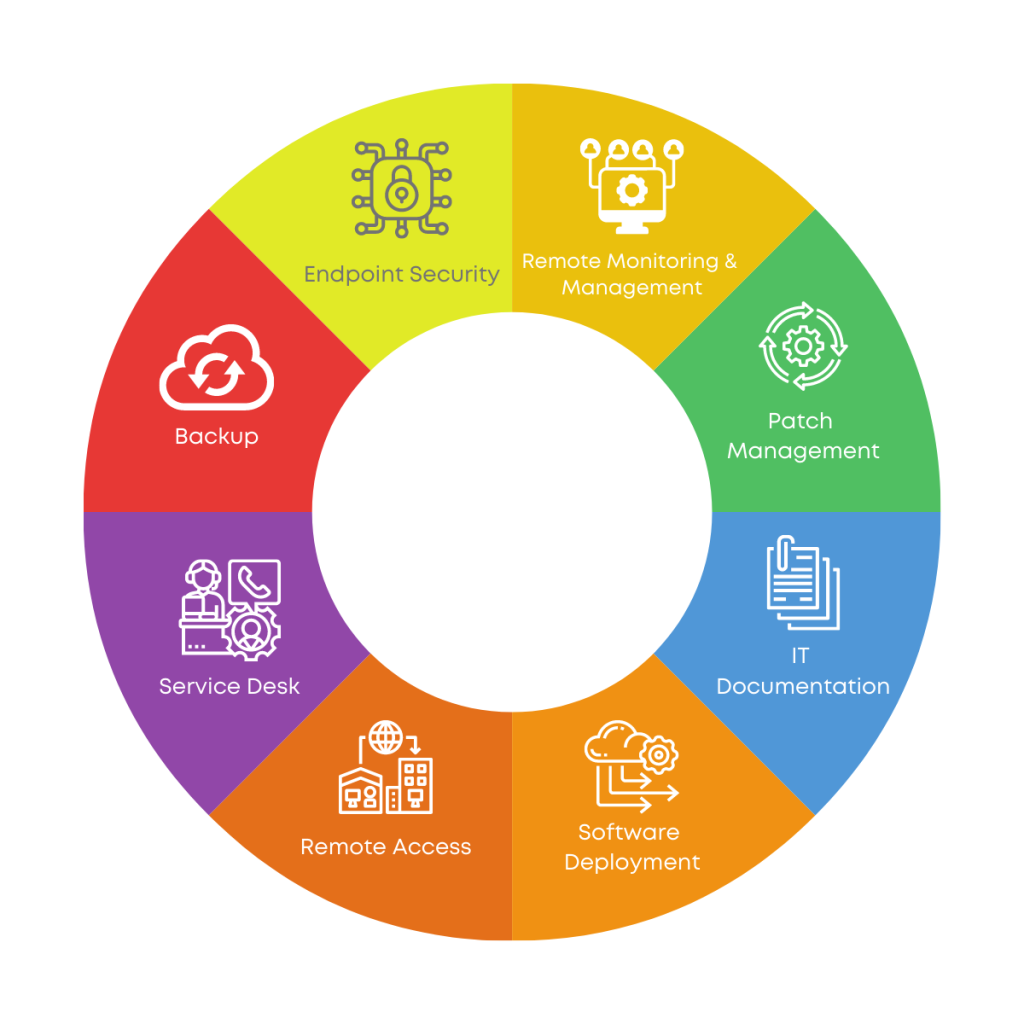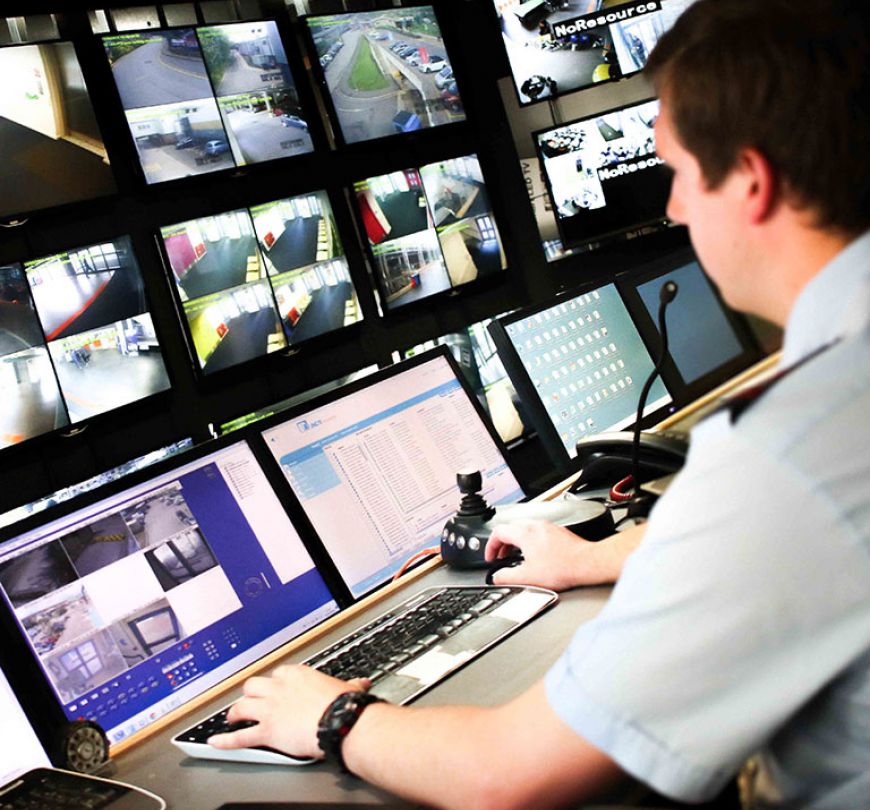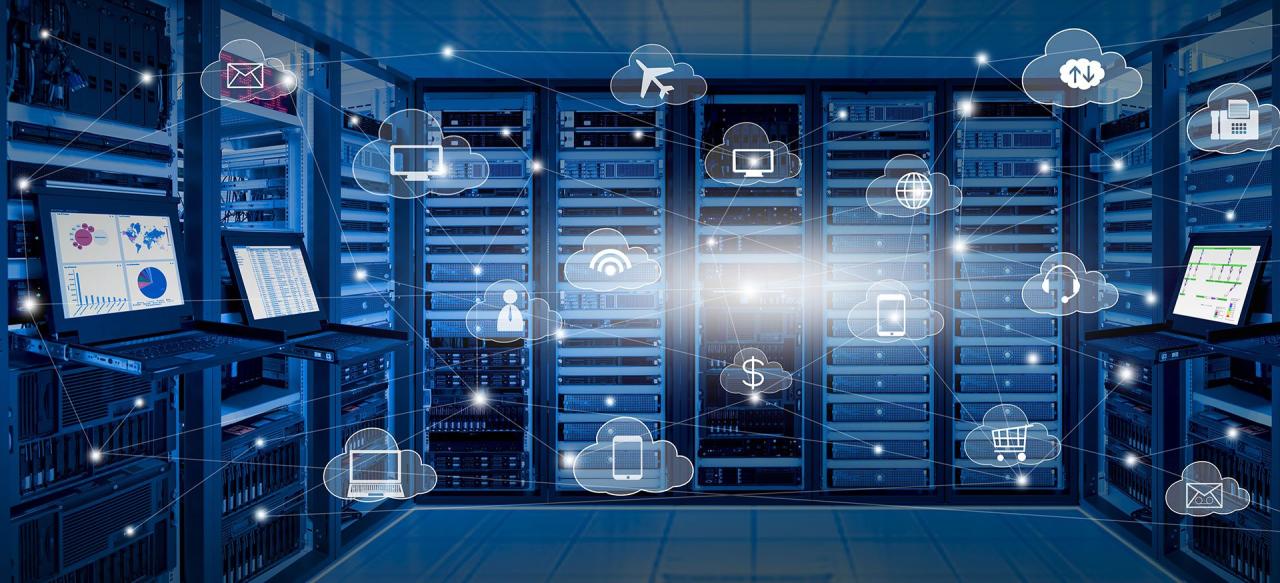Remote monitoring and management solutions are revolutionizing the way businesses manage their IT infrastructure. These powerful platforms offer a comprehensive suite of tools for monitoring, managing, and securing devices from a centralized location, regardless of physical location.
Table of Contents
Imagine having real-time visibility into the health of your network, proactively identifying and resolving issues before they impact your operations. RMM solutions empower IT teams to streamline their workflows, enhance security, and improve overall efficiency, freeing up valuable time for strategic initiatives.
Implementing and Configuring RMM Solutions
Remote monitoring and management (RMM) solutions are powerful tools for IT professionals to streamline operations, enhance security, and improve overall system health. Implementing and configuring an RMM solution effectively requires a strategic approach, taking into account specific needs and best practices.
Deploying an RMM Solution
Deploying an RMM solution involves several key steps that ensure a smooth transition and maximize its benefits.
- Choose the right RMM platform: The first step is to select an RMM platform that aligns with your specific needs and budget. Consider factors such as the number of devices to be managed, the level of automation required, and the features offered, such as remote access, patch management, and security monitoring.
- Install the RMM agent: Once you’ve chosen a platform, you need to install the RMM agent on all devices you want to manage. This agent collects data and allows the RMM platform to remotely control and monitor the devices. The installation process may vary depending on the RMM platform.
- Configure the RMM platform: After the agents are installed, you need to configure the RMM platform to meet your specific requirements. This includes setting up user accounts, defining policies, and configuring alerts.
- Test and monitor: After configuring the platform, it’s crucial to test its functionality and monitor its performance. This helps identify any issues or areas that need adjustments.
- Integrate with existing tools: Many RMM platforms offer integrations with other IT tools, such as ticketing systems, security software, and cloud services. Integrating these tools can further enhance the effectiveness of the RMM solution.
Choosing the Right RMM Platform
Selecting the right RMM platform is crucial for successful implementation. It’s essential to consider factors that align with your specific needs.
- Number of devices: The number of devices you need to manage will influence the choice of platform. Some platforms are better suited for small businesses with a limited number of devices, while others can handle large enterprises with thousands of devices.
- Level of automation: Consider the level of automation you require. Some platforms offer advanced automation capabilities, such as automated patch management and script execution, while others may have limited automation features.
- Features and functionalities: Evaluate the features offered by different platforms, such as remote access, patch management, security monitoring, and reporting. Choose a platform that provides the functionalities you need.
- Pricing and support: Consider the pricing model and support options offered by different platforms. Some platforms offer a subscription-based pricing model, while others may charge a one-time fee. It’s important to choose a platform that offers reliable support and meets your budget.
- Ease of use: Choose a platform that is easy to use and navigate, especially if your IT team has limited experience with RMM solutions.
Best Practices for Configuring and Customizing an RMM Solution
Once you’ve deployed an RMM solution, it’s essential to configure and customize it to optimize its performance and meet your specific needs.
- Define clear policies: Establish clear policies for managing devices, such as password requirements, software installation, and security settings. These policies should be enforced by the RMM platform.
- Set up alerts: Configure alerts for critical events, such as system failures, security breaches, and hardware issues. This allows you to quickly identify and address problems before they escalate.
- Automate tasks: Leverage automation features to streamline routine tasks, such as patch management, software updates, and backups.
- Regularly monitor performance: Monitor the performance of the RMM solution to ensure it is functioning as expected. Identify any bottlenecks or areas for improvement.
- Train your team: Provide your IT team with proper training on how to use the RMM solution effectively. This ensures they can leverage its features and troubleshoot any issues.
Real-World Applications of RMM Solutions
Remote monitoring and management (RMM) solutions are transforming the way businesses manage their IT infrastructure. These powerful tools offer a centralized platform for monitoring, managing, and securing endpoints, servers, and networks, empowering IT teams to be more efficient and proactive.
RMM in Different Industries
RMM solutions are not limited to any specific industry. They are widely adopted across various sectors, each with unique challenges and requirements.
- Healthcare: Healthcare organizations are subject to strict regulations and compliance requirements, including HIPAA. RMM solutions help them meet these standards by providing secure remote access, automated patching, and vulnerability scanning.
- Education: Educational institutions face the challenge of managing a large number of devices and users, often with limited IT resources. RMM solutions simplify device management, streamline software deployment, and enhance security posture.
- Financial Services: Financial institutions require robust security measures to protect sensitive customer data. RMM solutions provide real-time threat detection, endpoint security, and compliance reporting, ensuring data integrity and regulatory compliance.
- Manufacturing: Manufacturing companies rely on reliable IT infrastructure for production processes. RMM solutions ensure smooth operations by monitoring critical systems, automating tasks, and proactively addressing potential issues.
- Retail: Retail businesses with multiple locations need to manage IT infrastructure across dispersed locations. RMM solutions provide centralized management, remote support, and security monitoring, ensuring consistent IT performance and security.
Case Studies Demonstrating Impact
RMM solutions have a significant impact on business outcomes, improving efficiency, reducing costs, and enhancing security. Here are some real-world examples:
- A large healthcare provider implemented an RMM solution to manage its growing network of devices. The solution enabled them to automate patch management, reducing security vulnerabilities and improving compliance. The result was a significant decrease in security incidents and improved patient data security.
- A small educational institution adopted an RMM solution to manage its limited IT resources. The solution enabled them to remotely monitor and manage devices, reducing on-site support requirements and improving efficiency. The result was a significant reduction in IT support costs and improved student satisfaction.
- A financial services company deployed an RMM solution to enhance its security posture. The solution provided real-time threat detection, endpoint security, and vulnerability assessment, enabling them to proactively identify and address security risks. The result was a significant reduction in security incidents and improved customer trust.
Insights from IT Professionals
IT professionals who have implemented and utilized RMM solutions share valuable insights:
“RMM solutions have been a game-changer for our IT team. We can now manage our entire infrastructure from a single platform, reducing administrative overhead and improving efficiency.” – John Smith, IT Manager, ABC Company
“The proactive monitoring and automated patching capabilities of our RMM solution have significantly reduced the number of security incidents we experience. It has given us peace of mind knowing that our systems are protected.” – Sarah Jones, IT Director, XYZ Corporation
Future Trends in RMM: Remote Monitoring And Management Solutions

The realm of remote monitoring and management (RMM) is continuously evolving, driven by advancements in technology and the ever-changing landscape of IT security and management. RMM solutions are becoming increasingly sophisticated, incorporating cutting-edge technologies and methodologies to provide enhanced efficiency, security, and proactive IT support.
Integration with Artificial Intelligence and Machine Learning
The integration of artificial intelligence (AI) and machine learning (ML) into RMM solutions is revolutionizing how IT teams manage and secure their systems. AI and ML algorithms are capable of analyzing vast amounts of data, identifying patterns, and predicting potential issues before they occur.
- Proactive threat detection and prevention: AI-powered RMM solutions can analyze network traffic, user behavior, and system logs to identify suspicious activities and potential security threats in real-time. This proactive approach helps prevent breaches and minimizes the impact of cyberattacks.
- Automated incident response: AI can automate incident response procedures, reducing the time and effort required to address security threats. For example, AI-powered RMM solutions can automatically quarantine infected devices, block malicious traffic, and restore compromised systems.
- Predictive maintenance: AI and ML algorithms can analyze system performance data to predict potential hardware failures and software vulnerabilities. This allows IT teams to proactively schedule maintenance tasks and prevent downtime.
Enhanced Automation and Self-Healing Capabilities
RMM solutions are increasingly embracing automation to streamline IT processes and reduce manual interventions. This trend is driven by the need to improve efficiency, reduce operational costs, and enhance system reliability.
- Automated patch management: RMM solutions can automatically identify and deploy security patches and updates, ensuring that systems are always protected against the latest vulnerabilities.
- Self-healing capabilities: RMM solutions are incorporating self-healing capabilities, enabling systems to automatically recover from common errors and failures. This reduces downtime and minimizes the need for manual intervention.
- Automated task scheduling: RMM solutions can automate routine IT tasks, such as backups, system scans, and software installations, freeing up IT teams to focus on more strategic initiatives.
Increased Focus on Data Analytics and Insights
The volume of data generated by IT systems is increasing exponentially, creating a need for sophisticated data analytics tools to extract meaningful insights. RMM solutions are incorporating advanced analytics capabilities to provide IT teams with a deeper understanding of their systems and operations.
- Performance monitoring and optimization: RMM solutions can analyze system performance data to identify bottlenecks and areas for improvement. This data can be used to optimize system configurations, enhance resource utilization, and improve overall performance.
- Security threat analysis: RMM solutions can analyze security logs and threat intelligence data to identify potential vulnerabilities and security risks. This information can be used to implement appropriate security measures and prevent breaches.
- Trend analysis and forecasting: RMM solutions can analyze historical data to identify trends and patterns in system usage, security incidents, and performance metrics. This information can be used to forecast future needs and proactively address potential issues.
Growing Adoption of Cloud-Native RMM Platforms
The shift towards cloud computing is driving the adoption of cloud-native RMM platforms. These platforms offer several advantages over traditional on-premises solutions, including scalability, flexibility, and cost-effectiveness.
- Scalability and flexibility: Cloud-native RMM platforms can easily scale to meet the needs of growing businesses, without the need for significant upfront investments in hardware and infrastructure.
- Cost-effectiveness: Cloud-native RMM platforms typically offer a pay-as-you-go pricing model, which can be more cost-effective than traditional on-premises solutions.
- Accessibility and mobility: Cloud-native RMM platforms can be accessed from anywhere with an internet connection, providing IT teams with greater flexibility and mobility.
Security and Compliance Considerations

Remote monitoring and management (RMM) solutions offer significant advantages for IT departments, but they also introduce new security and compliance challenges. It is crucial to implement appropriate measures to ensure the security of sensitive data and compliance with relevant regulations.
Data Security
Data security is a paramount concern when utilizing RMM solutions. Unauthorized access to sensitive information can lead to significant financial losses, reputational damage, and legal repercussions. To mitigate these risks, organizations should adopt the following practices:
- Strong Authentication: Implement multi-factor authentication (MFA) for all user accounts accessing the RMM platform. MFA adds an extra layer of security by requiring users to provide two or more forms of identification, such as a password and a one-time code generated by a mobile app.
- Data Encryption: Ensure that all data transmitted between devices and the RMM platform is encrypted using industry-standard protocols like TLS/SSL. Encryption safeguards data from unauthorized access during transmission.
- Access Control: Implement granular access controls to restrict user access to specific devices, data, and functionalities based on their roles and responsibilities. This prevents unauthorized users from accessing sensitive information.
- Regular Security Audits: Conduct regular security audits to identify vulnerabilities and ensure that security measures are effective. These audits should include penetration testing, vulnerability scanning, and log analysis.
- Security Awareness Training: Train employees on cybersecurity best practices, including password management, phishing prevention, and malware awareness. This helps reduce the risk of human error, which can lead to security breaches.
Compliance Considerations
RMM solutions may be subject to various compliance regulations, depending on the industry, location, and the type of data being managed. It is crucial to understand and comply with these regulations to avoid penalties and maintain the trust of stakeholders.
- GDPR (General Data Protection Regulation): If the organization handles personal data of individuals within the European Union, it must comply with the GDPR, which mandates data protection, transparency, and individual rights.
- HIPAA (Health Insurance Portability and Accountability Act): Organizations in the healthcare industry must comply with HIPAA, which protects the privacy and security of protected health information (PHI).
- PCI DSS (Payment Card Industry Data Security Standard): Businesses that process credit card payments must comply with PCI DSS, which sets security standards for protecting cardholder data.
- SOX (Sarbanes-Oxley Act): Publicly traded companies must comply with SOX, which requires internal controls over financial reporting, including IT systems.
Best Practices for Security and Compliance, Remote monitoring and management solutions
To ensure the security and compliance of RMM solutions, organizations should adopt the following best practices:
- Choose a Reputable RMM Provider: Select an RMM provider with a strong track record of security and compliance, including certifications like ISO 27001 and SOC 2.
- Implement a Robust Security Policy: Develop a comprehensive security policy that Artikels the organization’s approach to data security, access control, and compliance.
- Regularly Update Software and Firmware: Keep all RMM software, operating systems, and applications updated to patch vulnerabilities and enhance security.
- Monitor Security Events: Implement security information and event management (SIEM) solutions to monitor security events, detect anomalies, and respond to incidents promptly.
- Regularly Review and Update Policies: Regularly review and update security and compliance policies to reflect changes in regulations, technologies, and threats.
Concluding Remarks

By embracing remote monitoring and management solutions, businesses can unlock a world of possibilities for their IT infrastructure. From boosting productivity and mitigating risks to optimizing costs and delivering exceptional user experiences, RMM solutions are a game-changer for organizations of all sizes. As technology continues to evolve, RMM platforms are poised to become even more sophisticated and integrated, further empowering businesses to navigate the complexities of the digital landscape.
Remote monitoring and management solutions are essential for businesses seeking to optimize their IT infrastructure. A key component of such solutions is inventory management, and ocs inventory provides a robust platform for this purpose. By efficiently managing your hardware and software assets, you can gain valuable insights into your IT environment, facilitating proactive maintenance and minimizing downtime.
